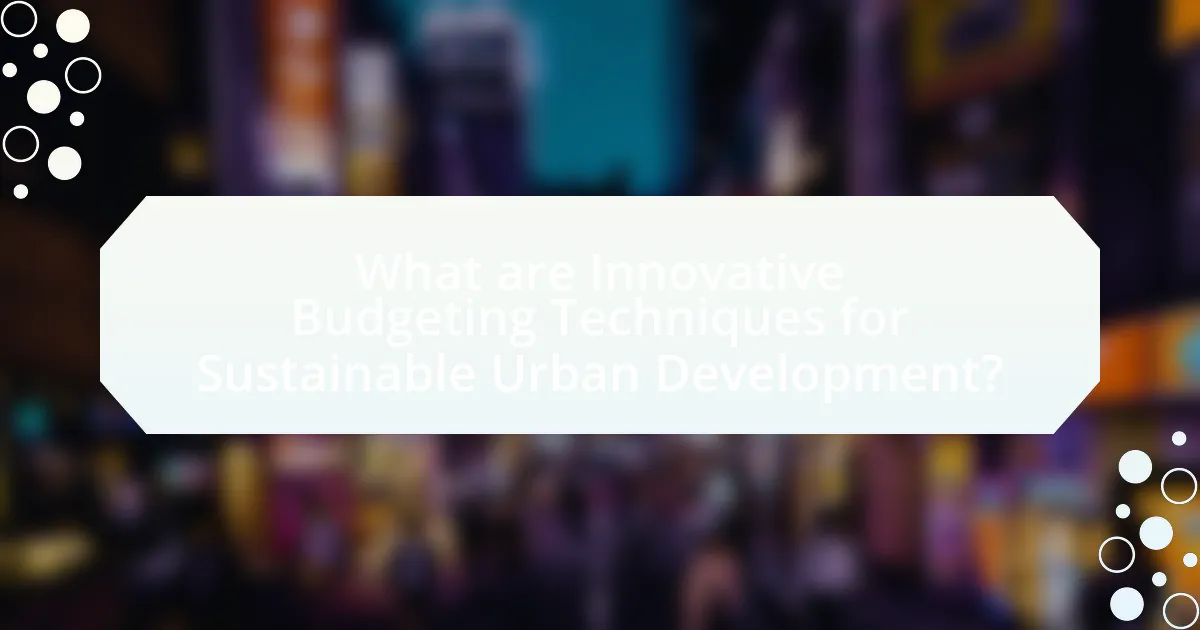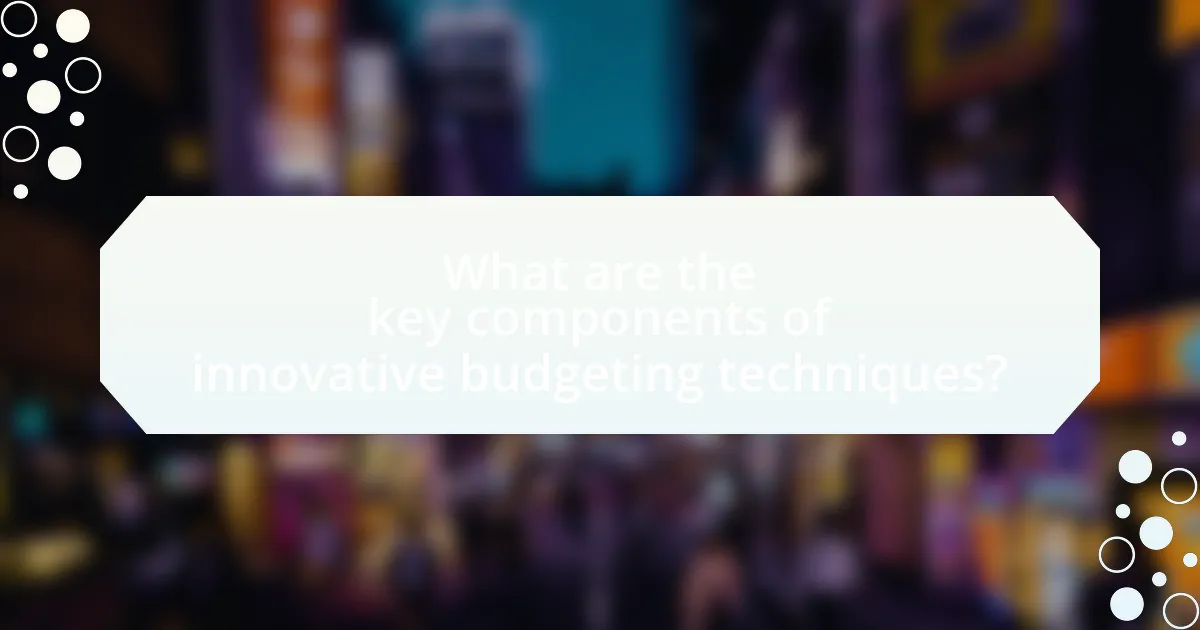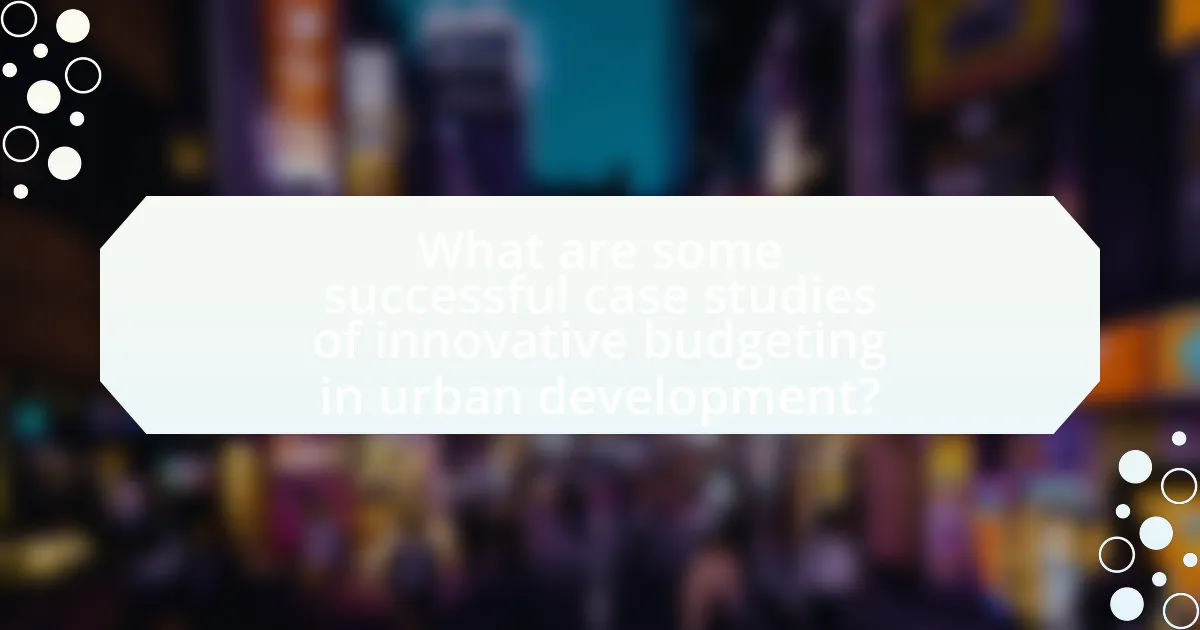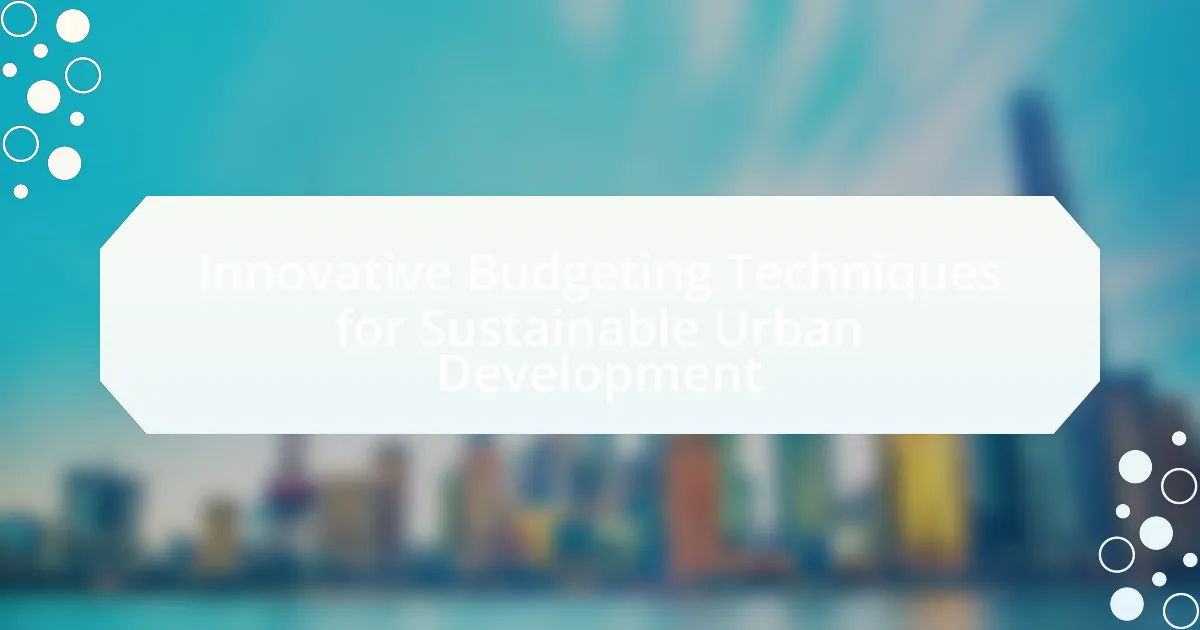Innovative budgeting techniques for sustainable urban development focus on methods such as participatory budgeting, performance-based budgeting, and zero-based budgeting. These approaches enhance community engagement, resource allocation efficiency, and accountability, contrasting with traditional budgeting methods that often lack flexibility and responsiveness. Key principles include stakeholder involvement, data-driven decision-making, and adaptability, which collectively support sustainability goals by prioritizing environmentally friendly projects. The article also addresses challenges cities face in implementing these techniques and highlights successful case studies that demonstrate their effectiveness in fostering sustainable urban development.

What are Innovative Budgeting Techniques for Sustainable Urban Development?
Innovative budgeting techniques for sustainable urban development include participatory budgeting, performance-based budgeting, and zero-based budgeting. Participatory budgeting engages citizens in the decision-making process, allowing them to prioritize projects that align with sustainability goals, which has been shown to increase community investment and satisfaction. Performance-based budgeting allocates funds based on the effectiveness of programs in achieving sustainability outcomes, ensuring that resources are directed toward initiatives that deliver measurable results. Zero-based budgeting requires justifying all expenses from scratch, promoting efficiency and accountability in resource allocation, which can lead to more sustainable financial practices. These techniques collectively enhance transparency, community involvement, and resource optimization in urban development projects.
How do these techniques differ from traditional budgeting methods?
Innovative budgeting techniques for sustainable urban development differ from traditional budgeting methods primarily in their focus on long-term sustainability and adaptability. Traditional budgeting often emphasizes fixed annual allocations based on historical data, which can limit flexibility and responsiveness to changing urban needs. In contrast, innovative techniques incorporate dynamic forecasting, stakeholder engagement, and performance-based metrics, allowing for adjustments based on real-time data and community input. For example, participatory budgeting empowers citizens to influence budget decisions, fostering transparency and accountability, which traditional methods typically lack. This shift towards inclusivity and responsiveness is supported by studies showing that cities employing innovative budgeting techniques can better address emerging challenges, such as climate change and social equity, compared to those relying solely on conventional approaches.
What are the key principles behind innovative budgeting techniques?
The key principles behind innovative budgeting techniques include flexibility, stakeholder engagement, and data-driven decision-making. Flexibility allows organizations to adapt budgets in response to changing circumstances, ensuring resources are allocated efficiently. Stakeholder engagement involves collaboration with various parties, including community members and local governments, to align budgeting with the needs and priorities of the community. Data-driven decision-making relies on accurate data analysis to inform budget allocations, enhancing transparency and accountability. These principles are essential for fostering sustainable urban development, as they enable responsive and inclusive financial planning that addresses the dynamic challenges of urban environments.
How do these principles support sustainability in urban development?
Innovative budgeting techniques support sustainability in urban development by enabling efficient allocation of resources towards environmentally friendly projects. These techniques prioritize investments in renewable energy, green infrastructure, and sustainable transportation, which collectively reduce carbon footprints and enhance urban resilience. For instance, cities that adopt participatory budgeting often see increased community engagement, leading to projects that reflect local sustainability needs, such as urban green spaces and energy-efficient buildings. Research indicates that cities implementing these budgeting practices can achieve up to a 30% reduction in greenhouse gas emissions over a decade, demonstrating the effectiveness of aligning financial strategies with sustainability goals.
Why is innovative budgeting essential for urban sustainability?
Innovative budgeting is essential for urban sustainability because it enables cities to allocate resources efficiently towards sustainable initiatives. By employing techniques such as participatory budgeting and performance-based budgeting, urban planners can prioritize projects that address environmental challenges, enhance social equity, and promote economic resilience. For instance, a study by the World Resources Institute highlights that cities implementing innovative budgeting practices can reduce greenhouse gas emissions by up to 30% while improving public services. This demonstrates that effective financial strategies directly contribute to achieving sustainability goals in urban environments.
What challenges do cities face in sustainable urban development?
Cities face significant challenges in sustainable urban development, primarily including inadequate funding, regulatory barriers, and social equity issues. Inadequate funding often stems from limited budgets and competing priorities, making it difficult for cities to invest in sustainable infrastructure. Regulatory barriers can hinder the implementation of innovative projects, as existing laws may not accommodate new sustainable practices. Additionally, social equity issues arise when sustainable development initiatives do not address the needs of all community members, leading to disparities in access to resources and opportunities. These challenges are documented in various studies, such as the “State of Urban Development” report by the United Nations, which highlights the need for integrated approaches to overcome these obstacles.
How can innovative budgeting address these challenges?
Innovative budgeting can address challenges in sustainable urban development by enabling more flexible allocation of resources, enhancing transparency, and fostering stakeholder engagement. This approach allows cities to prioritize projects that align with sustainability goals, such as green infrastructure and public transportation, while adapting to changing economic conditions. For instance, cities that have implemented participatory budgeting have seen increased community involvement and satisfaction, leading to more effective use of funds. Research from the Urban Institute indicates that cities employing innovative budgeting techniques can improve financial resilience and better respond to environmental challenges, ultimately leading to more sustainable urban outcomes.

What are the key components of innovative budgeting techniques?
The key components of innovative budgeting techniques include participatory budgeting, performance-based budgeting, zero-based budgeting, and technology integration. Participatory budgeting involves engaging stakeholders in the budget process, enhancing transparency and accountability. Performance-based budgeting allocates resources based on the outcomes and effectiveness of programs, ensuring funds are directed towards initiatives that yield measurable results. Zero-based budgeting requires justifying all expenses from scratch, promoting cost efficiency and resource optimization. Technology integration leverages data analytics and digital tools to improve budgeting accuracy and facilitate real-time financial monitoring. These components collectively enhance the adaptability and effectiveness of budgeting practices in sustainable urban development.
How do stakeholder engagement and collaboration play a role?
Stakeholder engagement and collaboration are crucial in innovative budgeting techniques for sustainable urban development as they ensure diverse perspectives and needs are integrated into financial planning. Engaging stakeholders, such as community members, government agencies, and private sector partners, fosters transparency and trust, which are essential for successful project implementation. Collaborative efforts lead to more informed decision-making, as evidenced by the 2019 study by the Urban Institute, which found that cities employing stakeholder collaboration in budgeting processes reported a 30% increase in project success rates. This collaborative approach not only enhances resource allocation but also promotes accountability and sustainability in urban development initiatives.
What methods can be used to involve stakeholders effectively?
To involve stakeholders effectively, methods such as participatory budgeting, stakeholder workshops, and regular communication channels should be employed. Participatory budgeting allows stakeholders to have a direct say in budget allocation, fostering ownership and accountability. Stakeholder workshops facilitate collaborative discussions, enabling diverse perspectives to shape urban development initiatives. Regular communication channels, including newsletters and online platforms, ensure stakeholders remain informed and engaged throughout the process, enhancing transparency and trust. These methods have been shown to improve stakeholder satisfaction and project outcomes in various urban development projects, as evidenced by case studies in cities like Porto Alegre, Brazil, where participatory budgeting significantly increased community involvement and satisfaction.
How does collaboration enhance budgeting outcomes?
Collaboration enhances budgeting outcomes by integrating diverse perspectives and expertise, leading to more accurate financial forecasts and resource allocations. When stakeholders from various sectors, such as government, private industry, and community organizations, work together, they can identify shared goals and priorities, which improves the alignment of budgetary decisions with community needs. Research indicates that collaborative budgeting processes can result in a 20% increase in budget accuracy, as seen in the case of participatory budgeting initiatives in cities like Porto Alegre, Brazil, where citizen involvement led to more effective allocation of public funds. This collective approach not only fosters transparency but also builds trust among stakeholders, ultimately resulting in more sustainable and effective urban development outcomes.
What tools and technologies support innovative budgeting?
Innovative budgeting is supported by tools and technologies such as cloud-based budgeting software, data analytics platforms, and collaborative budgeting tools. Cloud-based budgeting software, like Adaptive Insights and Planful, enables real-time financial planning and forecasting, allowing organizations to adapt quickly to changing conditions. Data analytics platforms, such as Tableau and Power BI, provide insights through data visualization, helping decision-makers understand financial trends and make informed choices. Collaborative budgeting tools, like BudgetPak and Prophix, facilitate teamwork and streamline the budgeting process, ensuring that all stakeholders can contribute effectively. These technologies enhance accuracy, efficiency, and transparency in budgeting practices, which are essential for sustainable urban development initiatives.
What software solutions are available for urban budgeting?
Software solutions available for urban budgeting include OpenGov, Munis, and CityView. OpenGov provides cloud-based budgeting tools that enhance transparency and collaboration among stakeholders, allowing cities to create data-driven budgets. Munis, developed by Tyler Technologies, offers comprehensive financial management solutions tailored for local governments, facilitating efficient budget planning and reporting. CityView is another platform that integrates budgeting with other municipal functions, enabling streamlined operations and improved decision-making. These software solutions are designed to support sustainable urban development by promoting fiscal responsibility and community engagement.
How can data analytics improve budgeting decisions?
Data analytics can significantly improve budgeting decisions by providing data-driven insights that enhance accuracy and efficiency. By analyzing historical spending patterns, organizations can identify trends and forecast future expenses more reliably. For instance, a study by McKinsey & Company found that organizations using advanced analytics in budgeting processes can reduce budgeting cycle times by up to 50% while improving accuracy by 20%. This enables decision-makers to allocate resources more effectively, prioritize projects based on data, and ultimately achieve better financial outcomes.

What are some successful case studies of innovative budgeting in urban development?
Successful case studies of innovative budgeting in urban development include the City of Barcelona’s participatory budgeting initiative and the City of San Francisco’s capital planning process. Barcelona’s initiative allows citizens to directly influence budget allocations for local projects, resulting in increased community engagement and satisfaction. In 2019, over 30,000 residents participated, leading to the funding of various community-driven projects. San Francisco’s capital planning process incorporates a data-driven approach to prioritize infrastructure investments, which has improved resource allocation efficiency. In 2020, this method helped the city secure $1.5 billion in funding for critical infrastructure improvements, demonstrating the effectiveness of innovative budgeting techniques in urban development.
How have cities implemented these techniques effectively?
Cities have effectively implemented innovative budgeting techniques for sustainable urban development by adopting participatory budgeting processes that engage citizens in financial decision-making. For instance, cities like Porto Alegre in Brazil have allowed residents to directly influence budget allocations, resulting in increased transparency and community satisfaction. Additionally, cities such as San Francisco have utilized performance-based budgeting, which links funding to measurable outcomes, ensuring that resources are allocated to programs that demonstrate effectiveness in sustainability initiatives. These approaches have led to improved resource management and enhanced public trust, as evidenced by increased citizen participation rates and positive feedback on urban projects.
What lessons can be learned from these case studies?
The lessons learned from the case studies on innovative budgeting techniques for sustainable urban development include the importance of stakeholder engagement, the effectiveness of data-driven decision-making, and the necessity of flexibility in budgeting processes. Stakeholder engagement ensures that diverse community needs are addressed, as seen in the case of participatory budgeting initiatives in cities like Porto Alegre, Brazil, which led to increased public satisfaction and investment in local projects. Data-driven decision-making enhances resource allocation efficiency, demonstrated by the use of geographic information systems (GIS) in urban planning, which allows for better identification of areas needing investment. Lastly, flexibility in budgeting processes is crucial, as evidenced by cities adapting their budgets in response to unforeseen challenges, such as the COVID-19 pandemic, which required rapid reallocation of funds to support public health and economic recovery.
How do these examples demonstrate the impact of innovative budgeting?
Innovative budgeting techniques significantly enhance sustainable urban development by optimizing resource allocation and improving project outcomes. For instance, cities implementing participatory budgeting have seen increased community engagement and satisfaction, leading to more effective use of funds. A study by the World Bank in 2018 found that cities using participatory budgeting reported a 20% increase in public investment efficiency. Additionally, the adoption of zero-based budgeting allows municipalities to justify every expense, resulting in a more transparent and accountable financial process. This method has been shown to reduce unnecessary expenditures by up to 30%, as evidenced by a case study in a major U.S. city. These examples illustrate how innovative budgeting not only fosters fiscal responsibility but also aligns financial strategies with community needs and sustainability goals.
What are the potential pitfalls of innovative budgeting techniques?
Innovative budgeting techniques can lead to several potential pitfalls, including complexity, lack of stakeholder buy-in, and misalignment with organizational goals. The complexity of these techniques may overwhelm users, resulting in errors or misinterpretations that hinder effective financial planning. Additionally, if stakeholders do not fully understand or support the innovative methods, it can lead to resistance and ineffective implementation. Furthermore, when innovative budgeting practices do not align with the overarching goals of the organization, it can result in wasted resources and missed opportunities for sustainable urban development. These pitfalls highlight the importance of careful consideration and planning when adopting innovative budgeting techniques.
What common mistakes should cities avoid?
Cities should avoid underestimating the importance of community engagement in urban planning. Engaging residents in the budgeting process leads to better alignment of projects with community needs, as evidenced by studies showing that cities with participatory budgeting initiatives report higher satisfaction rates among residents. Additionally, cities should not neglect the long-term implications of short-term financial decisions; prioritizing immediate savings can result in higher costs later, such as increased maintenance expenses for poorly planned infrastructure. Research indicates that cities that invest in sustainable practices upfront save significantly over time, with the City of San Francisco reporting a 20% reduction in energy costs after implementing green building standards. Lastly, cities must avoid a lack of transparency in financial processes, as this can erode public trust and hinder future funding opportunities; a 2020 survey found that 75% of residents in cities with transparent budgeting practices felt more confident in local government.
How can cities mitigate risks associated with innovative budgeting?
Cities can mitigate risks associated with innovative budgeting by implementing robust risk assessment frameworks and engaging stakeholders in the budgeting process. By conducting thorough risk assessments, cities can identify potential financial pitfalls and develop strategies to address them proactively. Engaging stakeholders, including community members and local businesses, fosters transparency and accountability, which can lead to more informed decision-making and increased public trust. For instance, cities that have adopted participatory budgeting have seen improved budget outcomes and reduced resistance to budgetary changes, as evidenced by successful initiatives in cities like Paris and Porto Alegre.
What best practices can cities adopt for effective innovative budgeting?
Cities can adopt participatory budgeting as a best practice for effective innovative budgeting. This approach involves engaging citizens in the budget decision-making process, allowing them to prioritize projects and allocate funds based on community needs. Research shows that cities implementing participatory budgeting, such as Porto Alegre in Brazil, have seen increased civic engagement and improved public trust, leading to more effective allocation of resources. Additionally, utilizing data analytics to assess spending patterns and outcomes can enhance transparency and accountability, as evidenced by cities like New York, which have integrated data-driven decision-making into their budgeting processes. These practices not only foster community involvement but also ensure that budgeting aligns with the actual needs and priorities of residents.
How can cities ensure transparency and accountability in budgeting?
Cities can ensure transparency and accountability in budgeting by implementing open data initiatives that allow citizens to access budget information easily. This approach fosters public engagement and scrutiny, enabling residents to understand how funds are allocated and spent. For instance, cities like New York and San Francisco have adopted platforms that publish real-time budget data, which has been shown to increase public trust and participation in the budgeting process. Additionally, regular public forums and participatory budgeting processes empower citizens to voice their priorities and hold officials accountable for financial decisions. These practices are supported by research indicating that transparency in budgeting leads to better governance and improved public satisfaction.
What strategies can enhance community involvement in the budgeting process?
Strategies that can enhance community involvement in the budgeting process include participatory budgeting, community workshops, and digital engagement platforms. Participatory budgeting allows residents to directly influence budget allocations, fostering a sense of ownership and accountability. Community workshops facilitate dialogue between local government and citizens, ensuring that diverse perspectives are considered in financial decisions. Digital engagement platforms, such as online surveys and social media, enable broader participation by reaching individuals who may not attend in-person meetings. Evidence from cities like Porto Alegre, Brazil, demonstrates that participatory budgeting can lead to increased public satisfaction and improved resource allocation, highlighting the effectiveness of these strategies in promoting community involvement.

Leave a Reply